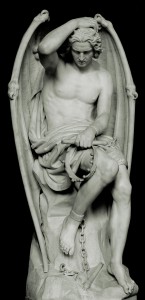Dear Father John, I have been working on my prayer life consistently for a few years. During this time I have been on retreats and other similar activities. I have noticed a strange pattern: the conservative groups I have had contact with talk a lot about spiritual warfare, but the less traditionalist groups don’t. Until now, I haven’t paid much attention to the  discrepancy. But lately I was wondering if maybe I should look into it – maybe understanding it better will help me grow spiritually?
discrepancy. But lately I was wondering if maybe I should look into it – maybe understanding it better will help me grow spiritually?
We have looked briefly at the reality of spiritual warfare, not as a distant and dramatic mystical phenomenon, but as the basic dynamism of our everyday life (Part I). And we have identified, again briefly, the three enemies against which we fight these spiritual battles: the world (understood as the sinful patterns of behavior that society in a fallen world tends to normalize), the flesh (the innate tendencies of our fallen nature that draw us towards self-centered decisions and habits), and the devil (Part II).
The devil was the first enemy that Jesus mentioned in his parable of the sower. There is something to that. We mustn’t forget that the devil is real, that he and his minions (the other angels that joined his rebellion against God and became demons) are our opponents, “prowling around like a roaring lion looking for (someone) to devour,” as St Peter explained it (1 Peter 5:8).
The devil prowls around in at least three different ways.
Possession
His most dramatic modus operandi is demonic possession. This involves the devil’s inner control of the actions of the human body. It can be permanent or intermittent. The Gospels describe multiple cases of demonic possession. Even in these cases, the victims maintain their free will – the devil can never force us to sin. Usually, possession occurs as the result of someone’s dabbling in occult or esoteric spiritual activities, or through a free descent towards progressively more decadent sinful activities. But sometimes a victim can have no culpability at all. The main objective of demonic possession is to terrorize the victim and cause suffering. It is a manifestation of the devil’s hatred for those whom God loves so thoroughly.
Obsession
His second-most dramatic mode of operation is demonic obsession. This involves attempting an external control of a victim’s body or senses. Obsession can at times be violent, leaving bruises and injuries (as in the case of St John Vianney, for example). More often it takes the form of an assault on a person’s powers of sight (disturbing visions), hearing (disturbing sounds), imagination (disturbing images), memory, or emotional equilibrium. The main objective of demonic obsession is to deceive the victim, wear them down spiritually, and induce sin.
Diabolical possession and obsession are real, and I am sure this very brief summary has sparked questions. To get answers, I highly recommend Fr. Gabriel Amorth’s book, An Exorcist Tells His Story. It is also available in audio format. Fr. Amorth was the long-time exorcist in the diocese of Rome. He wrote this book in accessible – not theological – language, precisely for normal Catholics.
Temptation
By far, however, the most common activity of the devil is simply temptation. The devil’s best allies are the other two enemies: our own fallen nature (the flesh), and the fallen world. Many times, those forces are sufficient to lead us into sin. They are especially sufficient when combined with our own self-centered habits, which most of us freely spend so much time perfecting during our childhood and youth.
But as we grow in our friendship with Christ, with the help of his grace, we also grow in virtue. The gifts of the Holy Spirit bolster our humble efforts to be courageous, patient, chaste, generous, wise, joyful, and self-forgetful. As we move towards or along this path of spiritual progress, or as we set out upon it, the devil will sometimes tempt us directly. He does this by intensifying (in our perception) the seductive attractions of the world, or by turbo-boosting the drives and the tug of the flesh.
Sometimes this activity is identifiable by its suddenness, violence, and persistence. But often the devil’s temptations are extremely subtle, barely discernible to our conscious mind. They usually consist in the devil’s putting an idea – a deceptive idea, a half-truth – in front of us. This deceptive, alluring idea is a hook that, if we latch onto it, will either draw us away from God’s will or draw our attention away from something God is trying to tell us.
Rather than giving specific examples of how this happens, I would like to point you to a resource that dramatizes the process with an entertaining and brilliant accuracy, C.S. Lewis’s classic, multi-generational bestseller, The Screwtape Letters. The book compiles thirty letters written from a senior devil to a junior devil about how to engage in the tricky game of tempting humans. And for those of you who do most of your “reading” with headphones on or while you’re driving, I can also recommend a compelling (and, again, entertaining) audio dramatization of that book, recently released by Focus on the Family Radio Theatre and available here (at a discount for our readers – see below!). If you have already read this book, I recommend that you re-read it every few years. Nothing I have found exposes the devil’s tempting tactics more thoroughly or more enjoyably.
Avoiding the Extremes
Whenever we talk or think (or read) about the devil, we have to be careful. It is dangerous for us to forget about him, but it is also dangerous for us to give him too much credit. It is not difficult for Jesus to keep the devil under control. The devil is a created being; God is the Creator. The devil must obey Jesus and is actually fearful of souls who are in the state of grace. True, he prowls around like a roaring lion, looking to make us fall into his deceits and traps so that he can devour us. But his activity is circumscribed by God’s wisdom and omnipotence.
We can avoid giving the devil too little or too much attention if we reflect on this number from the Catechism (#395), which sums things up nicely:
The power of Satan is, nonetheless, not infinite. He is only a creature, powerful from the fact that he is pure spirit, but still a creature. He cannot prevent the building up of God’s reign. Although Satan may act in the world out of hatred for God and his kingdom in Christ Jesus, and although his action may cause grave injuries – of a spiritual nature and, indirectly, even of a physical nature- to each man and to society, the action is permitted by divine providence which with strength and gentleness guides human and cosmic history. It is a great mystery that providence should permit diabolical activity, but “we know that in everything God works for good with those who love him.
We still have one more spiritual warfare related topic to cover: how to fight against our enemies. That, God willing, will be our next post.
Yours in Christ, Father John Bartunek, LC
+
Art for this Introduction to Spiritual Warfare post — What is the Devil Up To?: Statue en marbre de Lucifer (par Guillaume Geefs) à la cathédrale Saint-Paul de Liège (Belgique) [Marble Statue of Lucifer in Saint Paul Cathedral Liège, Belgium], Guillaume Geefs (1805-1883), 19th century, photographed by Luc Viatour / www.Lucnix.be, 2008, CCA-SA 3.0 Unported, Wikimedia Commons.





